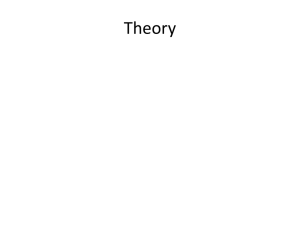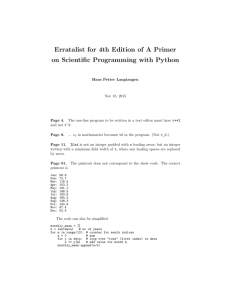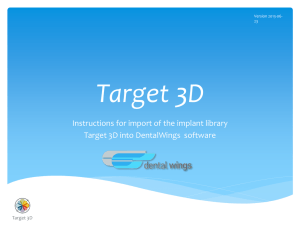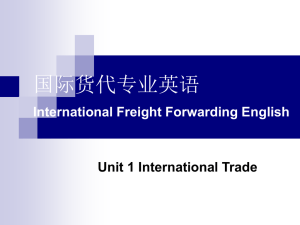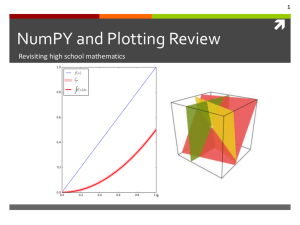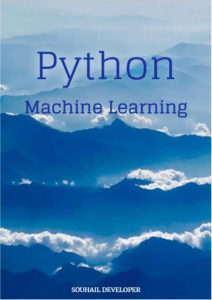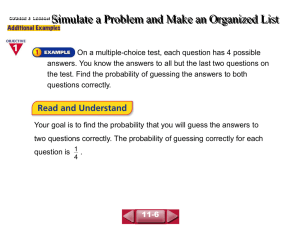Slides for Day 2
advertisement
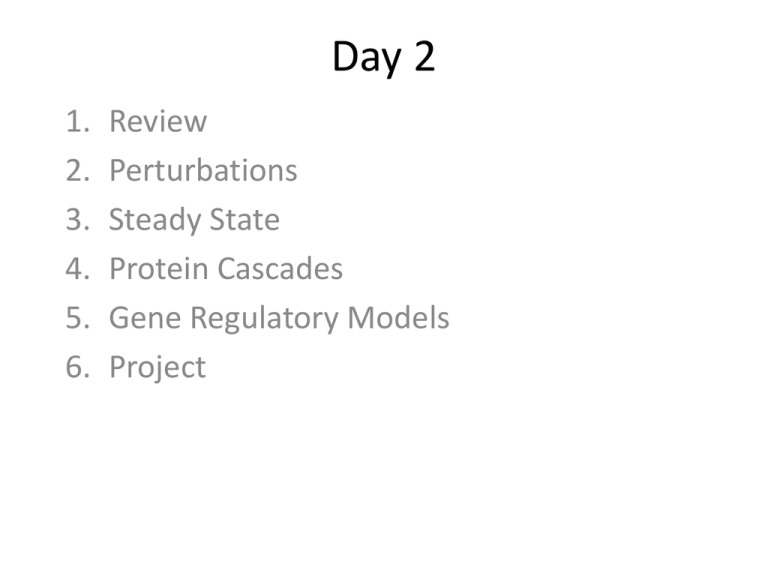
Day 2
1.
2.
3.
4.
5.
6.
Review
Perturbations
Steady State
Protein Cascades
Gene Regulatory Models
Project
Day 2
Template Script available at the web site.
Applying Perturbations in Tellurium
import tellurium as te
import numpy
r = te.loada (```
# Model Definition
v1: $Xo -> S1; k1*Xo;
v2: S1 -> $w;
k2*S1;
m1
m
m2
vstack ((m1, m2)) -> m
(augment by row)
# Initialize constants
k1 = 1; k2 = 1; S1 = 15; Xo = 1;
```)
# Time course simulation
m1 = r.simulate (0, 15, 100, [“Time”,”S1”]);
r.model.k1 = r.model.k1 * 6;
m2 = r.simulate (15, 40, 100, [“Time”,”S1”]);
r.model.k1 = r.model.k1 / 6;
m3 = r.simulate (40, 60, 100, [“Time”>,”S1”]);
m = numpy.vstack ((m1, m2, m3)); # Merge data
r.plot (m)
3
Perturbations to Parameters
Perturbations to Variables
import tellurium as te
import numpy
r = te.loada ('''
$Xo -> S1; k1*Xo;
S1 -> $X1; k2*S1;
k1 = 0.2; k2 = 0.4; Xo = 1; S1 = 0.5;
''')
# Simulate the first part up to 20 time units
m1 = r.simulate (0, 20, 100, ["time", "S1"]);
# Perturb the concentration of S1 by 0.35 units
r.model.S1 = r.model.S1 + 0.35;
# Continue simulating from last end point
m2 = r.simulate (20, 50, 100, ["time", "S1"]);
# Merge and plot the two halves of the simulation
r.plot (numpy.vstack ((m1, m2)));
Perturbations to Variables
6
More on Plotting
import tellurium as te
import numpy
import matplotlib.pyplot as plt
r = te.loada ('''
$Xo -> S1; k1*Xo;
S1 -> $X1; k2*S1;
k1 = 0.2; k2 = 0.4; Xo = 1; S1 = 0.5;
''')
# Simulate the first part up to 20 time units
m1 = r.simulate (0, 20, 100, ["time", "S1"]);
r.model.S1 = r.model.S1 + 0.35;
m2 = r.simulate (20, 50, 100, ["time", "S1"]);
plt.ylim ((0,1))
plt.xlabel ('Time')
plt.ylabel ('Concentration')
plt.title ('My First Plot ($y = x^2$)')
r.plot (numpy.vstack ((m1, m2)));
Three Important Plot Commands
r.plot (result)
# Plots a legend
te.plotArray (result) # No legend
te.setHold (True) # Overlay plots
Example of Hold
import tellurium as te
import numpy
import matplotlib.pyplot as plt
# model Definition
r = te.loada ('''
v1: $Xo -> S1; k1*Xo;
v2: S1 -> $w; k2*S1;
//initialize. Deterministic process.
k1 = 1; k2 = 1; S1 = 20; Xo = 1;
''')
m1 = r.simulate (0,20,100);
# Stochastic process.
r.resetToOrigin()
m2 = r.gillespie (0, 20, 100, ['time', 'S1'])
# plot all the results together
te.setHold (True)
te.plotArray (m1)
te.plotArray (m2)
Steady State
10
Steady State
11
Steady State
12
Open System, Steady State
r.steadystate();
This method returns a single number.
This number indicates how close the solution is to the steady state.
Numbers < 1E-5 usually indicate it has found a steady state.
Confirm using print r.dv()
<- prints rates of change
Useful Model Variables
r.dv()
<- returns the rates of change vector dx/dt
r.sv()
<- returns vector of current floating species
concentrations
r.fs()
<- returns list of floating species
names (same order as sv)
Useful Model Variables
r.pv() <- returns vector of all current parameter values
r.ps() <- returns list of kinetic parameter names
r.bs() <- returns list of boundary species names
Visualizing Networks
JDesigner
17
JDesigner
18
JDesigner
19
JDesigner
20
Protein Cascades
Cascades
Activator
Output
Properties of Protein Cycles
1. Build a model of a protein cycle
2 Use simple irreversible mass-action kinetics for the
forward and reverse arms.
3. Investigate how the steady state concentration of the
phosphorylated protein changes as a function of the
forward rate constant.
Cascades
Properties of Protein Cycles
1. Investigate what happens when you use simple
irreversible Michaelis-Menten Kinetics.
2. Investigate how the response changes as you
decrease the two Kms
Multiple Protein Cycles forming a
Cascade
Activator
Cascade two cycles together
Gene Regulation
Refer to writing board
Project
Degradation
E2
Activator
E1
S
E3
Metabolism
Gene Regulation
Protein Regulation
Project
Project: 1
Activator
Project: 2
Degradation
Activator
E2
E3
Project: 3
Degradation
E2
Activator
E1
S
E3
